I generally hold a fairly positive outlook on the world, despite the fact that we live under an increasingly restrictive and claustrophobic social structure. I attribute my jovial demeanor to the fact that I often find refuge from this hectic world in the most remote and beautiful areas that the United States has to offer: Our National Parks and Public Lands.
Unfortunately, I must admit that my refuge is shrinking… It’s shrinking fast!
And with the recent filming regulations handed down by the National Park Service, also shrinking is the public’s collective ability to tell meaningful stories from these treasured lands…
John Muir’s Written Stories from Public Lands
John Muir once wrote that “Thousands of tired, nerve-shaken, over-civilized people are beginning to find out that going to the mountains is going home; that wilderness is a necessity”
If this was the case in the 1860s, when Muir first entered the Yosemite Valley, one can only imagine what the world needs today. If tired, nerve-shaken, over-civilized people numbered in the thousands during Muir’s time, they must number in the tens or hundreds of millions in 2022.
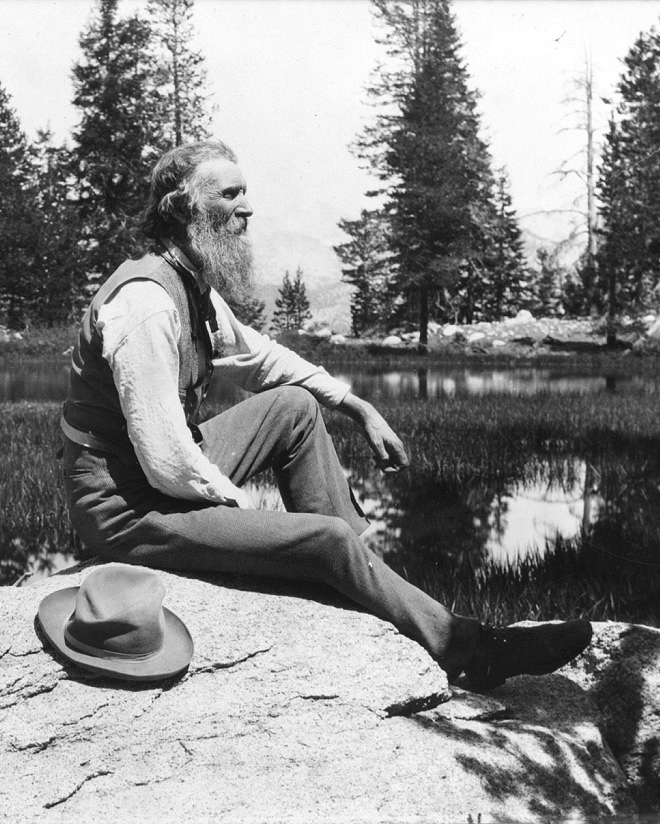
Inspired individuals such as Mr. Muir, have always sought to share their experiences in the wonderlands of our public wilderness. In his day, such folk would pen stories of their time in the wilderness, such as the “unknown nobody’s” detailed accounts of encounters with the various plants and trees situated along streams in the Yosemite high country.
As time passed, the spoken word became written, then recorded. Soon thereafter, words were joined with photographic images, eventually to be combined into the wonder of motion picture, which would soon enjoy the addition of audio to provide what we know today as modern film.
Modern Story Tellers Use Technology
Today, many evangelists of the natural arena create films set in our world’s most fantastic locations and detail their journeys through our national parks. The task of recording such stories is painstakingly endured by the filmmaker, often in hopes that those who view their content will one day do just as Muir did: drop everything and just head out into the mountains to “learn the news”. This is why I create online content.
I began to develop my vision for the Park Junkie Project back in 2016, during the 100th anniversary of our National Park System, which was a banner year for the parks and the idea of preserving public lands “for the benefit and enjoyment of the people”. I was already a lifelong visitor to these sacred shrines of unparalleled natural grandeur, having been to more than 50 national parks at that point.
As I searched for online content that detailed the adventures hidden within the remote regions of our beloved parks, I found the internet lacking in useful information. So my task began. I set out to build the most complete online guide to the national parks that could be found on the web.
I first assumed that the task would only take me a few months. I began to construct my website, filling it with scenic photographs and writings that would provide all the information which a would-be traveler could want in order to embark on the trip of a lifetime. Turns out… it’s taking me a helluva lot longer than a few months. I’m still working on this task six years later.
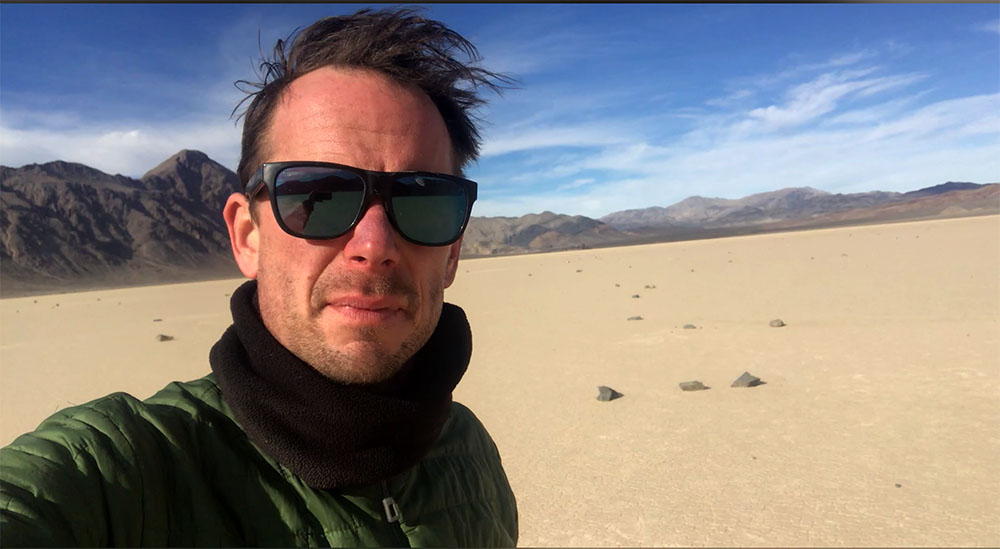
As the months became years however, technology developed. The modern mobile cellular device became a supercomputer, which included in its array of features, a camera that only a Hollywood filmmaker would have had access to a mere twenty years prior. With this tool in my hand, I slowly began to find myself choosing to press the record button more often that the shutter button. Video was just seemed to provide a more a complete product of storytelling.
My first attempts at filming my journeys in our national parks were comically frustrating. I can admit the comedic aspect to these attempts now, but in the beginning, my failures were certainly not something I found humorous. My on camera speech was an absolute disaster of word salads and shot exposures were constantly beyond any hope of “in-post” repair.
Anyone who observed the early ramblings of Park Junkie would certainly not suspect that any form of substance was likely to evolve from the primordial soup that was my early film productions… few of which were published by the way.
Fast forward six years. I now have three separate iPhones, one of which is dedicated to a drone, which I rarely fly, since they are prohibited in National Park lands, and one, a cracked older model, for filming more rugged scenes where it may fall and become damaged. My main phone is reserved for simply filming in hand on trail and setting on a tripod for passerby shots as I hike through the frame.
I have since abandoned all of my old SLR cameras, audio equipment and all of that bulky nonsense that I hated carrying anyway. I now shoot exclusively with a small, simple phone. I love it.
Why I Film on Public Lands
I thoroughly enjoy producing short videos of my adventures in the world’s most stunning landscapes. I make national park films with the desire that my content will encourage others to take to the hills in search of adventure, which I believe fuels the human soul like no other activity or pastime. I am of the opinion that time in nature combined with the physical and mental challenges encountered when traveling in such sacred earthly palaces make us better humans, both physically and spiritually.
I am also motivated by the realization that many in my viewing audience are simply watching my films because they have a special relationship with these lands. Perhaps they once enjoyed sunny afternoons in a particular park, or on a featured trail, with a loved one who is not with them anymore.
It is likely that some of my viewers simply cannot visit a particular remote location at this point in their life due to physical limitation or age, but they simply wish to relive their experience in that park through a film that takes them there, if only in their mind.
It may be that a viewer has a fond memory of a life-changing event or revelation that occurred when they visited that now sacred place. Emotional and spiritual overloads can easily happen in these lands… the power emitted by the earth in many wilderness temples is simply overwhelming. A simple mountain scene in these lands can drop a man to his knees in the middle of a trail, and somehow send tears streaming down his face in the light of a full moon. I’ve had it happen.
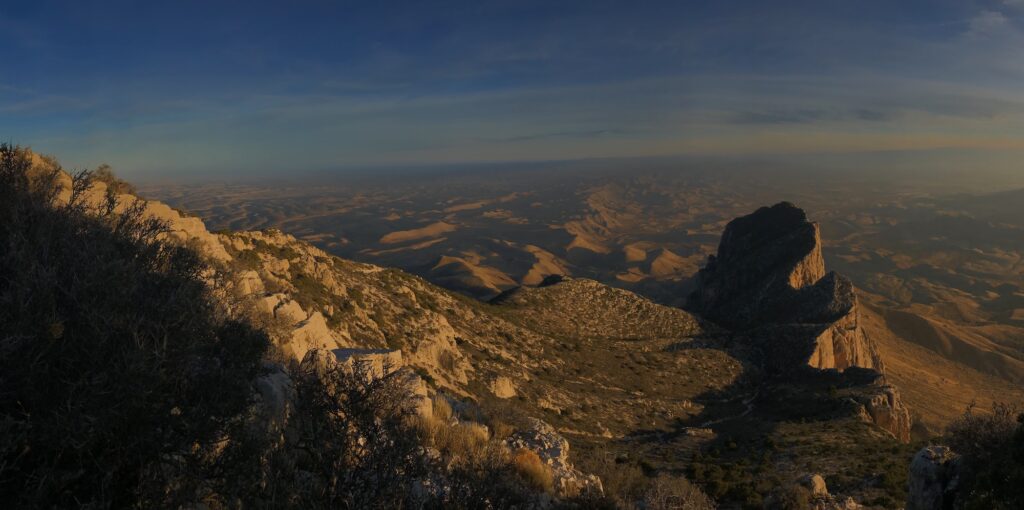
I am honored to be a vessel by which my viewers virtually tour these lands. I can only hope that my journeys into the grand wilderness of our parks and public lands provide the experience that my audience deserves, and I strive to cut no corner in the construction of my product. I wish to provide the best film possible for my viewers, and I do this every single time I venture into the hills with my camera.
Part of the Park Junkie mission in creating content on our federal lands is to simply convey the story of a particular park to my audience, so that they can remain continually informed of events during a disaster or emergency in a park. This desire guided my journalistic course during the catastrophic floods in Yellowstone National Park during the summer of 2022.
Information from the park was difficult to attain in the outside world, but as many have told me since, the reports that I dispatched via YouTube was the only real form of information that many could find. The Park Service personnel in Yellowstone certainly had their hands full with the disaster mitigation efforts underway on the ground, and I do indeed commend the Yellowstone NPS for their rather effective evacuation and re-opening process, as I’m sure there were a tidal wave of crisis-level responsibilities added to already strapped staff.
Complete news reports to the public from the park were, understandably, not their first concern. Thus, Park Junkie began to provide reports from the park, and the journalistic side of the channel began.
National Park Commercial Film Permit
Unfortunately, the National Park Service now wishes to silence filmmakers such as myself. For some reason, this federal agency is working diligently to cancel small story-telling creators and to suspend any ability of such creators to publish content filmed on public lands.
The Park Service has long had a commercial filming restriction in parks and on public lands at large. Any filmmaker involved in a film-for-profit production has been required to obtain a filming permit for decades. The reasons for this are fairly obvious. Most film productions have traditionally included a massive amount of gear and equipment, along with a number of gaffers, actors, directors and props that would fill a small town. The negative impact on the park and the visitor experience from such a complex process would likely be substantial.
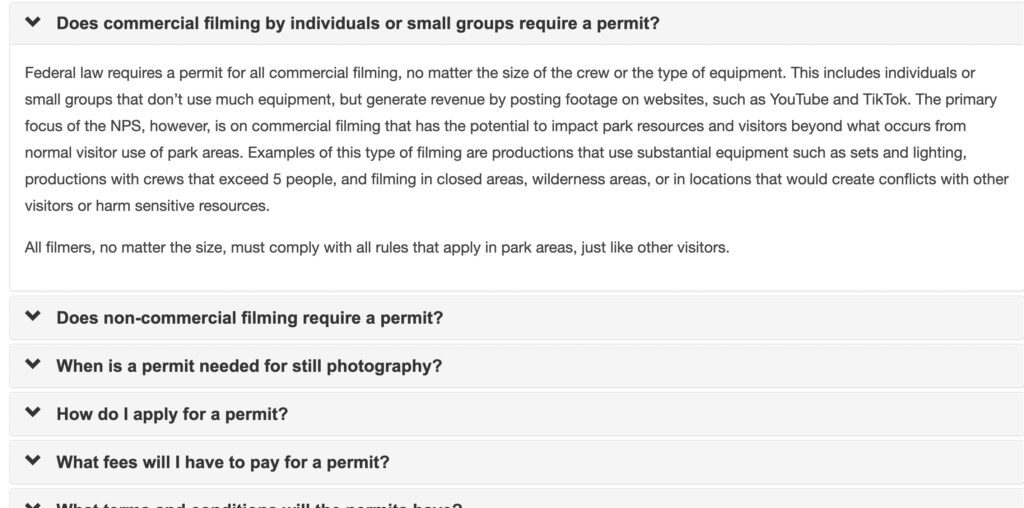
Thus, the parks required the permit, in order to pay extra staff to oversee the production and to lessen the impact such a massive set would have on visitors and the environment. This made sense, and it is unlikely that anyone really considered the fees associated with such undertakings offensive or unreasonable.
As humankind moved into the twenty-first century however, the advance of civilization brought with it the technological developments detailed above, and social networks such as YouTube, which enable the immediate dissemination of content to an online audience the world over. This enabled individual filmmakers to produce content “on-the-fly” without mounds of equipment or crews. Now the process of filming didn’t need to impart a negative impact on the land or the visitor experience.
National Park Service however policy, did not advance with technology. The commercial filming regulations that were put in place during the time of eight-track cassettes remained in place throughout this period of rapid technological advancement, which led to conflicts in the modern world.
Gordon Price & Crawford Road
Enter Gordon Price, a filmmaker from Yorktown, Virginia, who released a film called Crawford Road in 2018. Several scenes from his film were set in Colonial National Historic Park, which is managed by the National Park Service and is thus subject to public land commercial film permit requirements. Following the release of his film, park service officials paid a visit to Mr. Price, and issued him a citation for failing to procure a commercial filming permit.
Price was initially inclined to pay the fine, but upon consultation with legal counsel, decided to pursue a defense under the protection of the First Amendment’s guarantee of free speech.
The National Park Service was known to back down from such conflicts, presumably due to the fact that their own legal counsel likely knew that the requirement stood on shaky legal ground. Indeed, in this case, the NPS decided not to pursue the matter with Mr. Price, and dropped the matter.
Mr. Price Sues the National Park Service
Mr. Price however, was not so willing to walk away. He filed suit against the NPS on the grounds that the government agency had violated his rights to free speech. The case went to court, and in February of 2021, Judge Colleen Kollar-Kotelly, of the U.S. District Court for the District of Columbia declared the NPS regulation unconstitutional on the grounds that it violated free speech protections.
All looked good at that point, as the NPS placed an interim guidance for filming in parks on their Office of Communications webpage. This update removed the permit requirement for “low-impact” filming, while maintaining such requirements for “other filming activities” which may cause “potential impacts to resources and the visitor experience”.
This could have been the end of it, and the park service could have let it be. It was clear that “low-impact” filmmakers were not harming the environment or the park visitor experience, and that the rules were written in a by-gone era. Nevertheless, the NPS upper brass bureaucrats quietly went about appealing their case for restrictions on free speech to a higher court.
NPS Wins on Appeal
As we all know, the wheels of justice are slow. It took a year and a half for the case to make its way to a decision. On August 23, 2022 the ruling came down in the appeals case, now filed as Price v. Garland. What formerly seemed like a solid win for the rights of the people, became another feather in the hat of big government. The court reversed the lower district court’s ruling and dealt a blow straight to the chin for advocates of free speech.
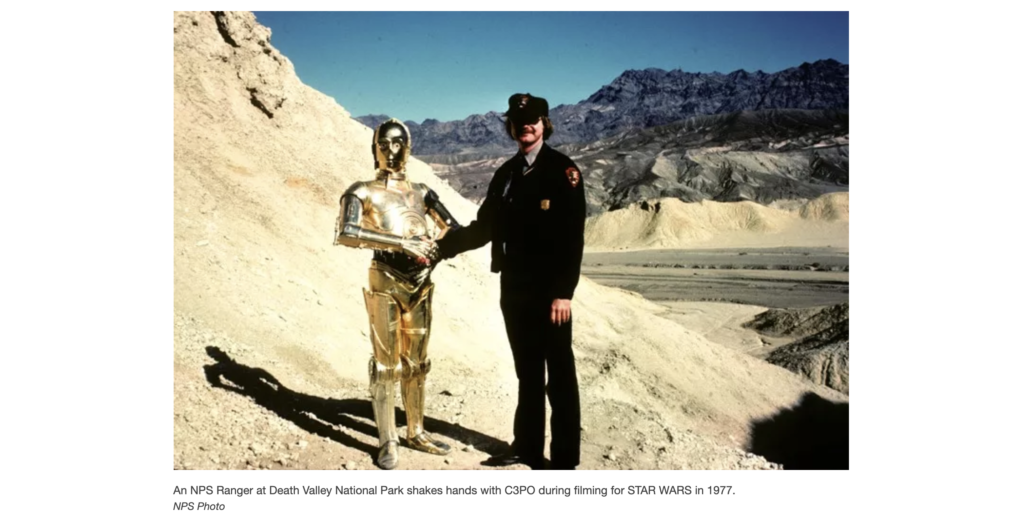
In a 2 to 1 decision, the higher court’s Judge Douglas Ginsberg penned an opinion that many in the legal community will likely find perplexing. He reasoned that although some portions of the national park system are public forums, where open public discourse would be protected, a public forum analysis does not apply to filmmaking, because “a filmmaker does not seek to communicate with others at the location in which he or she films, the filmmaker does not use the location as a forum”.
Having arrived at this conclusion, two justices out of three declined to apply the classic “public forum” analysis, and further held that filmmaking “is not itself a communicative activity, it is merely a step in the creation of speech that will be communicated at some other time, usually in some other location”.
Thus, the free speech protections of the First Amendment did not apply to Mr. Price. The court held that the NPS regulations on free speech were indeed, constitutional.
Judge David Tatel Dissents
While two misguided judges found that the rights of free speech did not apply to filming on public lands, one did. Judge David Tatel penned a scathing dissent, in which he wrote that “By stripping public forum protection from filming, my colleagues – for the very first time – disaggregate speech creation and dissemination, thus degrading First Amendment protection for filming, photography, and other activities essential to free expression in today’s world”.
Judge Tatel went on to explain, “My colleagues reimagine the public forum to protect the stumping politician but not the silent photographer, to shield the shouting protester but not the note-taking reporter”, he wrote. “These distinctions find no basis in First Amendment jurisprudence. It makes no more sense to exclude certain types of speech from public forums than it does to police which squirrels may enter a conservation easement.”
The dissenting justice went on to explain that the public forum analysis should depend on the forum, not on the type of expressive activity that takes place within the forum. He added, “By stripping filming of the protections afforded to expression in public forums, the court puts us in direct conflict with other circuits and leaves important expressive activities unprotected in places where the First Amendment’s guarantee of free speech should be at its apex.”
I’m not exactly a legal scholar… and I don’t recommend you take legal advice from me on important matters, but I’m inclined to agree with Judge Tatel.
In this decision, the court has effectively made a distinction based on where one’s audience is located during the speech. Essentially, this court is saying that since a filmmakers audience is not present at the location of the filming, there exists no right to free speech.
Welcome to the new America kids… Now shut up and do as you’re told…
Why did the NPS Appeal the Decision?
Many would be inclined to ask the question, “why would the park service want to restrict the free speech of YouTube creators?”, and this is a valid inquiry. Truth is, there’s likely a complex set of surrounding issues at hand, and I’m not really sure what the end game is here for the park service. If I were to speculate, I’d have to be quite conspiratorial in my judgment, and I’d be inclined to suggest that the reasons go far beyond the NPS. But we’ll save those conversations for another time.
New Commercial Film Permits
Following the ruling, the NPS left the interim regulations in place, but it didn’t take long for their wretched attorneys to come up with a new set of guidelines which this time explicitly mentioned producers on YouTube and TikTok.
Strangely, the newly announced rules mentioned in the very next line, that the “primary focus of the NPS, however, is on commercial filming that has the potential to impact park resources and visitors”.
Basically, if one were to read between the lines, the park service is saying that it’s technically illegal for low-impact YouTubers and Tiktokers to film in national parks without a permit, but they’ll just look the other way, unless those filmmakers use substantial equipment, such as sets and lighting.
In this case, we’re left with an arbitrary set of rules, that may, or may not be applied at the discretion of a park ranger. This raises a plethora of valid concerns.
What if that park ranger does not like your content? What if that park ranger just doesn’t like the clothes you wear? The hairstyle you wear? The nose ring in your nose? Those tattoos on your arm? Or on your face? What if that ranger just doesn’t like your race? Your gender? Your religious affiliation? What if that ranger just doesn’t like YOU?
So yeah, the National Park Service just canceled free speech for YouTubers and Tiktokers.
What the New Permits Require
So the question may be on your mind: “Well Park Junkie, what is the hassle in obtaining a permit? Why are you so opposed to this permit?”
Well, aside from the absolute violations of free speech and freedom of the press that I see written upon the face of these tyrannical regulations, we can focus on the fact that they are a burdensome pain in the ass for anyone who wants to subject him or herself to dealing with another form of government bureaucracy.
First of all, the application process is horrendous. An application must be filed, by mail, with an application fee (non-refundable, of course) which ranges anywhere between $100 and $200, depending on the park in which it is filed. The application does not guarantee a permit.
Many locations have a set time period during which the filming must take place, and those vary from site to site. Some locations, such as Independence Hall require that the filming take place during hours when there are no guests on location, so the filmmaker would need to be there after closing. This of course, would necessitate the payment of park staff to be on hand during such time, which the filmmaker will need to pay.
Filming is restricted to confined areas in many parks, and furthermore, as I understand it currently, there can be no filming at all in Wilderness Areas, which comprises the largest sections of nearly all national parks. If you can’t film in the Wilderness Areas, what the hell are you really going to film in a national park anyway?
The applications require that filmmakers list their social security numbers, tax id numbers, license plate numbers, and a list of information that would make you think you’re applying for a mortgage on a seven figure home. I imagine that the new patron scandal saint Samuel Bankman Fried didn’t even do this much paperwork when he filed with the SEC to start FTX… I digress…
Continuing on the paperwork front, the list of questions continues: What areas do you intend to film? When? How? With whom? What kind of underwear will you be wearing? Etc…
Also of concern, and probably the most atrocious requirement on the list is the need to obtain a $1,000,000 insurance policy that names the NPS as a beneficiary in the event that the filmmaker destroys or damages park property or resources.
Now if you know anything about federal government expenditures, you’ll understand that it wouldn’t take much damage to a handrail to eat up that 7 figure policy, so you can bet your ass that an insurance company is going to juice the filmmaker good for that policy.
This list could go on, but I think you get the point. At least you should.
Where Do We Go From Here?
Following the ruling, I stepped back for some time, and contemplated the future of the Park Junkie Project. Consideration of the appalling assault on the freedoms guaranteed by our nation’s constitution aside, how could the park service even justify their stance in becoming such an overbearing beast in our nation’s march toward tyranny? These are sacred grounds after all!
Would John Muir, Frederick Law Olmsted, Stephen Mather or Theodore Roosevelt arrive at the conclusion that individuals should not be allowed to film freely in their nation’s most scenic and revered lands? No, certainly not! These men are rolling over in their graves right now! The long fight for the preservation of public lands means nothing if a nation’s citizens do not hold the right to freely enjoy their lands, and many enjoy such lands by making films that celebrate these lands.
Many more, who indeed may never find the necessary funding, time or physical ability to visit these lands, enjoy them through the productions of filmmakers like me. Filmmakers who are now told that they cannot film on these lands without securing a permit from our Federal Masters. Thus, many among our population will be refused the right and ability to click on a thumbnail and watch a film that showcases the geologic and historic wonders of more than 425 units of the national park service.
These lands are our nation’s treasures, America’s Best Idea in the words of writer and historian Wallace Stegner. (Although this term is now attributed to Ken Burns, its origins lie with Stegner, who said the parks are “the best idea America ever had.”). Are we now to just accept that we cannot share footage from these lands? That somehow, we should just abdicate the mission of telling the stories of these lands? Just leave that up to National Geographic, they are the professionals after all. What can we YouTubers and Tiktokers possibly bring to the table that Nat Geo can’t?
I’ll tell you what we can bring to the table that Nat Geo can’t. Authenticity.
We bring real people on the scene. Real everyday, hard-working, men and women from every possible background and from every possible avenue of life. People with truth. People with spirit. People with grit. People with a story to tell. People with a future…
We don’t bring people with 7 figure insurance policies… We don’t bring corporate entities with multi-level marketing programs… We don’t bring the same old story you’ve been told for the past 50 years by big Hollywood light, camera, action assholes… We don’t bring Ivy League degrees or press badges from CNN or FOX news… We don’t bring obnoxious elites with an agenda laid out by the oligarchy… and we certainly don’t bring permits for free speech.
We don’t need those. We have the constitution of the United States and its First Amendment, which applies to each and every one of us… & that’s the only permit we need.
National Park Service Cancels Free Speech for YouTubers
relavent links
NPPA Article on Price v Barr (now Price v. Garland)
Park Junkie YouTube – Commercial Film Permit Discussion
RV Miles YouTube – Commercial Film Permit Discussion
